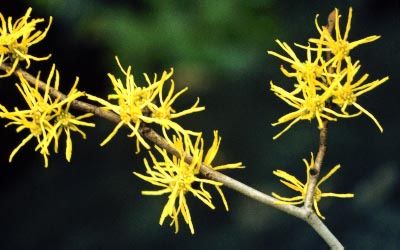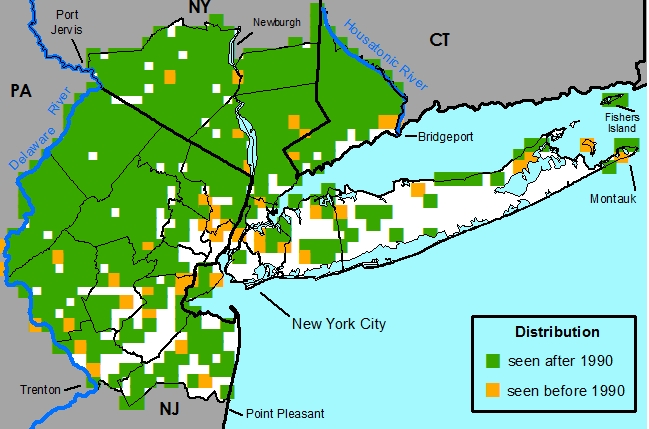Hamamelis virginiana L. - Witch Hazel,American Witch Haz

Native , Common
By Steven D. Glenn & Angela Stewa
Not peer reviewed
Last Modified 02/06/2013

Common Names
Witch Hazel,American Witch HazDescription
PLANTS Perennial, deciduous, phanerophytic, shrubs, diclinous and monoecious, with adventitious roots, 1-5 m tall, plants suckering, forming dense clumps.STEMS Main stems erect, round, appearing round or square in cross section. Prickles absent. Bark smooth, not exfoliating, gray to silver, rough in parts. Branches erect. Twigs light gray to silver, brown, not odoriferous, round to square in shape, 3-5 mm in diam., smooth, glabrous, sessile glands clustered, dark orange-red in color. Pith white, round to oval, continuous, nodal diaphragm absent. Thorns absent. Aerial roots absent. Sap translucent. Resin absent.
BUDS Terminal and axillary bud present, scattered along stem. Bud scales and scars absent. Leaf scars elongate (heart shape), 2 mm high, 4 mm wide, size and shape vary greatly. Vascular bundle scars 3, circular.
LEAVES Alternate, simple, 1-2 per node, spaced somewhat evenly along stem, divergent from stem. Lateral stipules present, leaf-like. Leaves petiolate, petiole flattened, 1-1.5 cm long, papillose or with short and unbranched hairs or apically with a branched spreading hairs, moderately dense, and distributed throughout. Petioles not glabrescent, pubescence most dense at base of petiole. Leaf blades: abaxial surface light green to light green yellow, adaxial surface green to yellowish green, obovate, plane, asymmetric, 3.5-17 cm long, 3-13 cm wide, chartaceous, base oblique to rounded, sometimes cuneate, crenate margin, apex acute, short acuminate or broadly rounded, abaxial surface glabrous or with long white, erect and unbranched hairs, sparsely, distributed along midveins. Surfaces glabrescent and without glands. Leaves palmately or pinnately veined with 5-7 pairs of veins. Leaf lobes 1 symmetrical. Leaf apices acute or obtuse, sinuses rounded, unlobed. Spines absent. Tendrils absent.
INFLORESCENCES Bisexual, simple, other, terminal or axillary, inflorescence indeterminate. Peduncle present. Rachis absent.
FLOWERS Precocious, formed on last season's growth, bisexual, with sepals and petals readily distinguishable from one another, 4-merous, 10-12 mm long, 5-7 mm wide, 3-5 flowers per inflorescence, fragrance present, perianth of one whorl. Calyx present, stereomorphic, crateriform, of fused sepals, persistent, abaxial and adaxial surfaces not the same color, gray, light yellowish orange, blocking, 4 mm long, 5 mm wide, tube 3 mm long, 3 mm wide. Sepals or sepal lobes 4, linear triangular or narrowly elliptic, 3-4 mm long, 3-4 mm wide, base obtuse, margin entire, abaxial surface with short and unbranched hairs, spreading, light yellowish orange, moderately dense, distributed throughout, not glabrescent, without glands. Corolla present, zygomorphic, of free petals, deciduous, abaxial and adaxial surfaces the same color, yellow, blocking, 10 mm long, 1.2 mm wide. Linear, plane, 12 mm long, 3 mm wide, base acute, margin entire, apex acute, abaxial surface glabrous, glands absent, adaxial surface glabrous, without glands, petals linguliform. Gynoecium syncarpous. Carpels 2, carpels carpels often diverge and separate apically. Locules 2, locules often all but 1 locule aborting. Stigmas 2, linear, 0.2 mm long. Styles 2, 2-3 mm long, styles spreading to recurved. Ovary semi-inferior, 1.5 mm long, 3 mm wide, oval, with short and unbranched hairs, glands absent. Androecium alternate, monadelphus, included, haplostemous, introrse. Stamens 4, 2 mm long, opening along the long axis, opening 1/4 of entire anther, orange-red, glabrous, eglandular. Filaments straight, yellowish orange, glabrous.
FRUITS Light brown capsule, round to oval, 10-12 mm long, 8-14 mm wide, with short, erect unbranched hairs, light orange-yellow, in color, sparse, distributed apically, glabrescent, and eglandular.
SEEDS Seeds 2, black, oval, 5-9 mm long, 3-5 mm wide, glabrous, eglandular, wingless, not tailed, smooth.
Habitat
Dry to mesic woodland slopes, moist woods, fallow fields, alluvial woods, and high hammocks.Distribution
United States -- AL, AR, CT, DC, DE, FL, GA, IA, IL, IN, KY, LA, MA, MD, ME, MI, MN, MO, MS, NC, NH, NJ, NY, OH, OK, PA, RI, SC, TN, TX, VA, VT, WI, WV.Canada – NB, NS, ON, PE, QC.
New York Metropolitan Region – Native to the NYMF area. Reported in all 25 counties in our range.
Rarity Status
Heritage global rank – G5Connecticut – S5
New Jersey – S5
New York – S5
Species Biology
FloweringSeptember [ week 3] – November [week 1]
Pollination
Wind and insect pollinated.
Fruiting
June [week 2] – July [week 4]
Dispersal
?
Germination
Dormancy broken by warm stratification.